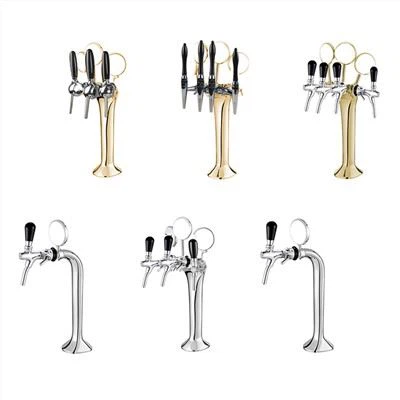
Plastic Beer Tower
A beer tower is a beer dispensing device, sometimes found in bars, pubs and restaurants. The idea behind beer towers is that several patrons in a group can serve themselves the amount of beer they want without having to order individually. The beer tower is connected to kegs housed in a cooler or refrigerator, ensuring that the beer remains cold and fresh. It's a convenient and visually appealing way to serve draft beer, providing patrons with easy access to a variety of beverages without the need for individual taps for each keg.
- Fast Delievery
- Quality Assurance
- 24/7 Customer Service
Product Introduction
What is Plastic Beer Tower
A beer tower is a beer dispensing device, sometimes found in bars, pubs and restaurants. The idea behind beer towers is that several patrons in a group can serve themselves the amount of beer they want without having to order individually. The beer tower is connected to kegs housed in a cooler or refrigerator, ensuring that the beer remains cold and fresh. It's a convenient and visually appealing way to serve draft beer, providing patrons with easy access to a variety of beverages without the need for individual taps for each keg.
Advantages of Plastic Beer Tower
Beer Improves Blood Circulation
Beer increases your "good" cholesterol, or HDL (high-density lipoprotein) cholesterol. It's basically a kind of blood fat, so it reduces blood's tendency to clot.
Beer is Chock Full o' Fiber
The fiber comes from the cell walls of the malted barley. A liter of beer can have as much as 60% of your daily recommended fiber. The extra fiber will keep you regular and can also lower the risk of heart disease.
Beer as a Multi-vitamin
Beer is a significant source of magnesium, selenium, potassium, phosphorus, biotin, folate, vitamin B6 and vitamin B12.
Beer is Good for your Liver
Alcohol expands the small blood vessels in the liver. This speeds up metabolism so it can help clean all the toxins out of the liver. This is from Beer Net Publication, April 2001 Biological Institute.
Why Choose US
One-stop solution
With rich experience and one-to-one service,we can help you choose products and answer technical questions.
01
Customization services
They provide customization services to meet specific customer requirements, ensuring that clients receive products that exactly fit their needs.
02
Innovation
We are dedicated to improving our systems continually, ensuring that the technology we offer is always cutting edge.
03
24h online service
We try and respond to all concerns within 24 hours and our teams are always at your disposal in case of any emergencies.
04
Choosing the Right Tower for Your Draft System
There are a couple of things you'll want to know before selecting your draft tower:
Most home draft beer enthusiasts own a kegerator, which is known as a direct draw draft system. Kegerators for home use typically use what we refer to as a standard draft beer tower or draft arm that mounts to the top of the refrigerator. This tower style is suitable for serving 1-3 different types of beer at a time, depending on how many kegs your kegerator can hold.
Commercial establishments can also have a direct draw system, whether it's a kegerator stored under a bar or counter or if they have a cooler or refrigerated area adjacent to the point of distribution with the tower and faucets mounted to the adjoining wall. Commercial kegerators and walk-in coolers can hold more kegs than residential units, which allows you to use a tower that can hold more than three taps.
A long-draw draft system is required for areas where kegs cannot be stored in or near the same space you are pouring them from. Long-draw systems deliver draft beer from your cooler to the draft tower through insulated beer lines. These beer lines are kept chilled as they travel from the kegs to the draft tower to prevent the beer from pouring foamy and prevent the formation of bacteria in the lines. As stated earlier, air-cooled and glycol are two methods for cooling beer in a long-draw draft system. A draft tower compatible with the method of cooling used for your system is required to keep the beer inside your tower properly chilled.
A glycol-cooled beer tower has room to fit the trunk line. From there, the coolant line runs across glycol cooling blocks inside the tower to help keep the beer cool and then runs back out of the tower to return the glycol to the chiller via the trunk line. Air-cooled towers receive chilled air, which is directed into the draft tower by an air baffle and air separator, while spent air is sent back through the ducts to the cooler.
Temperature Tips for Storing Your Draft Beer
Temperature is critical for two main reasons when it comes to storing your draft beer. The first is that warmer temperatures will cause your beer to go flat faster. The second reason is that warmer temperatures will cause the flavors in your beer to change and become less enjoyable. If you're looking to fix your kegerator we suggest reading more here.
The ideal draft beer temperature for storing draft beer is between 36-48 degrees Fahrenheit. This range will keep your beer from going flat and will also maintain the flavor profile that the brewer intended.
If you can't store your draft beer in this temperature range, it's still important to keep it as cool as possible. Warmer temperatures will cause your beer to go flat and change flavor more quickly, so it's best to err on the side of caution.
The ideal temperature for storing draft beer is between 36-48 degrees Fahrenheit. If you can't store your beer in this range, it's still important to keep it as cool as possible. Warmer temperatures will cause your beer to go flat and change flavor more quickly, so it's best to err on the side of caution.
Drastic temperature changes can also cause your beer to go flat and change the flavor. So, it's best to avoid storing your beer in a place where the temperature fluctuates frequently.
Heat sources, like furnaces or ovens, can cause your beer to age prematurely. So, it's best to avoid storing your beer near any heat source.
While the fridge is a great place to store your beer if you can't keep it at the ideal temperature, you don't want to store it in there for too long. The colder temperatures in the fridge can cause the flavors in your beer to change. So, if you're planning on storing your beer in the fridge, it's best to drink it within a few weeks.
Light can also cause your beer to go flat and change the flavor. So, it's best to store your beer in a dark place, like a closet or cupboard.
If you're storing your beer in a cool place, like a fridge or cellar, it's best to not stack it too high. Stacking your beer too high can block the circulation of air, which can cause your beer to go flat.
If you want to store your beer at the ideal temperature, but don't have a fridge or cellar, you can use a wine chiller. Wine chillers are designed to keep wine at the ideal temperature, and they'll work just as well for beer.
If you're going to be storing your beer in a warm place, like a garage or shed, you can wrap it in a wet towel. The evaporating water will help keep your beer cool.
If you're going to be storing your beer for a long period of time, it's best to use an insulated cooler. Insulated coolers will keep your beer at a consistent temperature for a longer period of time.
If you want to store your beer at the ideal temperature, the best solution is to buy a beer fridge. Beer fridges are designed to keep beer at the ideal temperature, so you don't have to worry about your beer going flat or changing flavor.
How Many Beers Can a Standard Beer Tower Hold
Capacity in bottles, pints, and glasses
The capacity of a beer tower can vary greatly depending on its size and design.
A standard beer tower typically holds between 2 and 3 liters (roughly equivalent to 4 to 6 pints) of beer or around 5 to 7 bottles, depending on the bottle size. A tower may store up to 7-8 standard beer glasses in terms of glass capacity.
The impact of different beer types and sizes
The amount of beer a tower can hold also depends on the type of beer and the size of the glass or bottle. For instance, a pint of stout may measure differently than a pint of lager or ale. When determining how many bottles, pints, or glasses of beer a tower can hold, it is essential to consider the specific beer type and size.
Comparing beer tower capacities to kegs and packs
When comparing the capacity of a beer tower to other beer storage options such as kegs or packs, a beer tower will typically hold less beer than a standard keg (which usually contains around 15 gallons, roughly equivalent to 124 pints or 165 12-ounce bottles) but potentially more than a pack (which typically includes 6 or 12 cans or bottles).
How Do You Pour and Serve Beer from a Beer Tower
Using beer taps to dispense the beverage
To pour and serve beer from a beer tower, use the beer tap or dispenser at the tower's base. Tilt the glass at a 45-degree angle and open the faucet, allowing the beer to flow gradually down the inside of the glass. This technique ensures a smooth, consistent pour while minimizing excess foam.
Tips for properly pouring beer from a tower
When pouring beer, Keep a few things in mind. Firstly, avoid overfilling the glass or running too quickly, which can cause excessive foam buildup.
Additionally, letting the beer flow smoothly down the side of the glass helps maintain a balance between the liquid and foam.
Keeping the beer fresh and cold: insulation and CO2
Beer towers, especially those with built-in insulation or cooling mechanisms, are vital in keeping beer fresh and cold throughout a party or event.
Quality and taste are preserved by protecting the beer from external temperature fluctuations and exposure to light. CO2, commonly used in kegs and sometimes incorporated into beer towers, is another way of maintaining freshness by providing constant pressure to keep beer carbonated.
What Should You Consider When Purchasing a Beer Tower
Finding the right size and capacity for your needs
The most crucial consideration when purchasing a beer tower is finding the right size and capacity to suit your needs. Consider factors such as how many bottles, pints, or tubes you plan to serve in one sitting, the types of beers you will provide, and the size of your establishment or event.
Material and design: functionality meets style
Choose a beer tower material and design that fits your needs, preferences, and overall aesthetic. Glass towers look elegant, while plastic towers are lightweight and affordable. Metal towers often lend an upscale appearance that complements the décor of a stylish bar or brewery. Weigh each material's benefits and drawbacks before deciding to ensure lasting satisfaction with your purchase.
Price and maintenance factors of a beer tower
Finally, consider the price and maintenance involved when purchasing a beer tower. Glass and metal towers may be more expensive than plastic towers. Still, they tend to be more durable and aesthetically appealing. Factor in the cost of cleaning, maintaining, and replacing parts (such as taps and connectors) over time to make an informed decision on your investment.
How Many Beers Are in a Keg
A keg is a cylindrical container that stores and dispenses beer. In the US, the standard size of a full keg or half a barrel contains 15.5 gallons (57.8 litres) of beer which amounts to around 661 ounces, 41 pints, or 55 cans or bottles (12 oz).
You can also find smaller-capacity kegs. For instance, a sixth barrel holds 5.16 gallons (19.5 litres), while pony and slim quarter kegs can carry 7-7.75 gallons (26-29 litres). All these kegs can carry different numbers of beers. However, a typical keg's capacity is 165, 12 fluid ounces of beer.
Some produce other keg sizes, such as 50-litre / 13-gallon barrels that you'll often find in commercial brewers.
How Much Does a Full Keg of Beer Weigh
A full keg of beer typically weighs around 160 pounds or 72 kilograms and can contain between 14-15 gallons or 165 12oz servings of beer. The keg's weight determines how you transport, handle, and store it.
The number of beers in a full keg can range between 165-198 depending on the size and type of beer. For example:
An Anchor Steam Beer has about 16 gallons or 150 12-ounce glasses in one full half-barrel keg
Heineken Lager has slightly more weight, with 14.5 gallons or 169 10 ounces per glass
Guinness has fewer at 13 gallons per 174 than ounce glasses.
The variation means that when tapping a keg, you must consider how much alcohol you provide guests based on size and volume so they don't overindulge.
The sixth barrel keg: How does it weigh and what's the number of beer in it
A sixth-barrel keg is a smaller-sized beer container than the half-barrel keg commonly seen in pubs and bars. Holding 5.2 gallons of beer with standard 12-ounce pints, this size of keg typically contains 82 beers or 62 pints when filled.
Weighing 97 pounds when full and 30 to 45 pounds when empty, this keg is relatively lightweight compared to the half-barrel, which weighs around 160 lbs total and 120 lbs empty.
The sixth barrel keg is also known as Torpedo Keg because its shape is slimmer than most other barrels. However, its smaller size and light weight make it ideal for transportation.
The quarter barrel keg: How much does weigh and what's the number of beer in it
A quarter barrel keg, commonly called a pony keg, Cornelius Keg, or stubby quarter, typically weighs 80 pounds when total and 15 pounds when empty. The barrel can hold 82 12-ounce cans or bottles of beer.
The quarter barrel keg has a capacity of 7.75 gallons or 30 litres. Its small size makes it transportable and an ideal choice for events with fewer people attending, such as birthday parties or smaller gatherings.
The light weight also makes handling easier than larger kegs. Due to their compact design, you'll appreciate their weight if you have limited labour but want to haul beer from one place to another without taking up too much space on vehicles.
The slim quarter keg: How much does it weigh and what's the number of beer in it
The slim quarter keg, or torpedo keg, is a space-saving and cost-effective beer storage option. An empty slim quarter keg weighs approximately 19 pounds and 90 pounds when full of beer.
It has a capacity of 7.75 gallons, or 40 pints in 16 ounces each, when serving beers via a pint glass. You can get 53 12-ounce beercans or bottles from a full slim quarter keg. Its medium makes it exceptionally versatile for smaller events or establishments requiring fewer beer quantities.
Half barrel keg: How much does it weigh and what's the number of beer in it
A half-barrel keg, or 1/2 BBL, is a large cylindrical container for storing and dispensing beer. These kegs typically contain up to 15.5 gallons of liquid-equivalent to 165 12-ounce beers or 124 pints-and weigh around 159 pounds when full.
Although the keg size can vary due to manufacturer differences, a standard size measures 16 inches wide by 23½ inches tall (including feet). When empty, a half-barrel keg will typically weigh around 30 pounds.
While the half-barrel keg is excellent for large parties or events, you might face inefficiencies during transportation or storage because of its heavy weight.
50 litre keg: How much does it weigh and what's the number of beer in it
The 50 Litre keg is a popular size for beer in the hospitality industry and has become one of the go-to sizes used. Standing about 23.3 inches (59.2 centimetres) tall, the 50-litre keg holds up to 103 pounds of beer or 50 litres, which equates to around 13.2 gallons or 268 U.S. pints.
This capacity makes it an excellent option for events such as festivals or large parties, as it allows for an abundant supply that caters to many people.
An empty 50L keg weighs approximately 27 pounds, while a full-size keg weighs 130 pounds (the majority being beer).
Mini keg: How much does it weigh and what's the number of beer in it
Mini kegs are an excellent option for reducing waste and keeping beer fresh. These smaller kegs, usually holding 5 litres, can hold up to 14 bottles (12 ounces each) of beer or 10 pints (16 ounces).
Mini kegs are much more compact and portable than full-size ones like the half barrel. However, mini kegs have low capacity making them less cost-effective if you expect a large turnout at your event. The container can only carry 103 pounds of beer.
Given their small-size nature, portability factor, and good storage capabilities, mini kegs are the ideal choice for events with limited space, such as camping trips or home parties.
Certification
Pera Industry Co.,Ltd has been certified by ISO 9001 International Quality Management System and CCC(China Quality Certification Center). The whole process of production, management, and after-sales service is organized by the company. The quality of our products is in leading leval both at home and abroad, which is stable and reliable.








FAQ
Q: What is a plastic beer tower?
Q: What are the advantages of using a plastic beer tower?
Q: Can a plastic beer tower be used indoors?
Q: How do I set up a plastic beer tower?
Q: What size keg does a plastic beer tower accommodate?
Q: Can I use a plastic beer tower with a corny keg?
Q: How do I keep beer cold in a plastic beer tower?
Q: How do I clean a plastic beer tower?
Q: Can I leave beer in a plastic beer tower for extended periods?
Q: Are plastic beer towers compatible with all types of beer?
Q: Can I use a plastic beer tower with a nitrogen system?
Q: How do I prevent foam when pouring from a plastic beer tower?
Q: What is the lifespan of a plastic beer tower?
Q: Can I repair a damaged plastic beer tower?
Q: How do I store a plastic beer tower when not in use?
Q: Can I purchase a custom-designed plastic beer tower?
Q: What safety precautions should I take when using a plastic beer tower?
Q: Can I use a plastic beer tower for commercial purposes?
Q: What are some common problems with plastic beer towers and how do I fix them?
Q: Are there any environmental considerations when using a plastic beer tower?
Hot Tags: plastic beer tower, China plastic beer tower manufacturers, suppliers, factory, beer tower with led lights, industrial pipe beer tower, u type keg connector, 1 keg, two faucet beer tower, kegerator cooling tower
No Information











